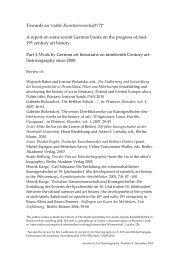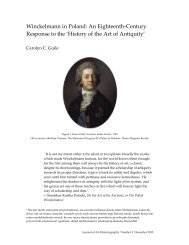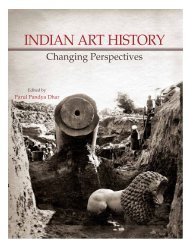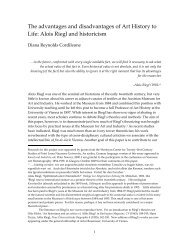Moving the body painting into the art gallery - Journal of Art ...
Moving the body painting into the art gallery - Journal of Art ...
Moving the body painting into the art gallery - Journal of Art ...
You also want an ePaper? Increase the reach of your titles
YUMPU automatically turns print PDFs into web optimized ePapers that Google loves.
Howard Morphy <strong>Moving</strong> <strong>the</strong> <strong>body</strong> <strong>painting</strong> <strong>into</strong> <strong>the</strong> <strong>art</strong> <strong>gallery</strong><br />
elements that would occur on <strong>body</strong> <strong>painting</strong>s in a wide range <strong>of</strong> ceremonial contexts<br />
or bark bone containers.<br />
The first bark <strong>painting</strong>s from Eastern Arnhem Land that were made for sale to<br />
Europeans fall <strong>into</strong> one <strong>of</strong> two categories, <strong>painting</strong>s based on ancestral designs<br />
associated with p<strong>art</strong>icular places and secular <strong>painting</strong>s largely comprised <strong>of</strong><br />
figurative representations that Yolngu refer to as wakinngu — a term which can be<br />
loosely translated as ordinary or mundane or colloquially as ‘hunting story’. The<br />
sacred <strong>painting</strong>s were <strong>the</strong> kind <strong>of</strong> <strong>painting</strong>s that would be painted on a boy’s chest<br />
prior to circumcision or on a <strong>body</strong> prior to burial. This association is reflected in <strong>the</strong><br />
fact that a number <strong>of</strong> <strong>the</strong> early bark <strong>painting</strong>s collected by <strong>the</strong> anthropologist Donald<br />
Thomson and missionary Wilbur Chaseling conformed to <strong>the</strong> structure <strong>of</strong> <strong>body</strong><br />
<strong>painting</strong>s, including <strong>the</strong> extensions <strong>of</strong> <strong>the</strong> design down <strong>the</strong> thigh and <strong>the</strong> lines drawn<br />
over <strong>the</strong> shoulders (figure 5).<br />
Figure 5 Fish Trap at Baraltja, 1942. Bark <strong>painting</strong> by Mundukul Marawili. Collected by Donald Thomson<br />
at Caledon Bay on 17/9/1942, while he commanded <strong>the</strong> Special Reconnaissance Unit <strong>of</strong> Eastern Arnhem<br />
Land ‘warriors’ to monitor Japanese activity. The <strong>painting</strong> represents <strong>the</strong> Mouth <strong>of</strong> <strong>the</strong> Baraltja River<br />
associated with <strong>the</strong> ancestral snake Burrut’tji or Mundukul. The background design represents <strong>the</strong> form<br />
<strong>of</strong> an ancestral fish trap made out <strong>of</strong> <strong>the</strong> snake’s ribs, and <strong>the</strong> flow <strong>of</strong> brackish water through <strong>the</strong> river<br />
mouth during <strong>the</strong> wet season. The Donald Thomson Collection on loan to Museum Victoria from The<br />
University <strong>of</strong> Melbourne. Copyright <strong>the</strong> <strong>art</strong>ist’s family. Reproduced courtesy <strong>of</strong> Buku-Larrnggay Mulka<br />
<strong>Art</strong> Centre.<br />
Later on <strong>the</strong>se additions were left out but <strong>the</strong> designs were <strong>of</strong> <strong>the</strong> same type<br />
and centred on a p<strong>art</strong>icular place. These <strong>painting</strong>s reflected <strong>the</strong> underlying structure<br />
<strong>of</strong> clan <strong>painting</strong>s in which a core design exists for each yindi yaku (big named) place<br />
10
















